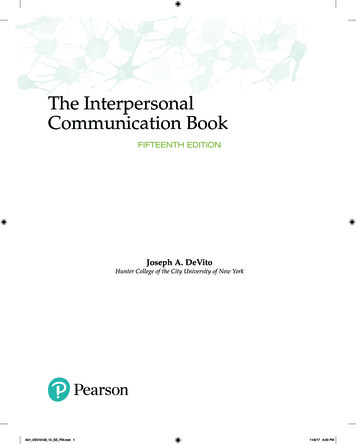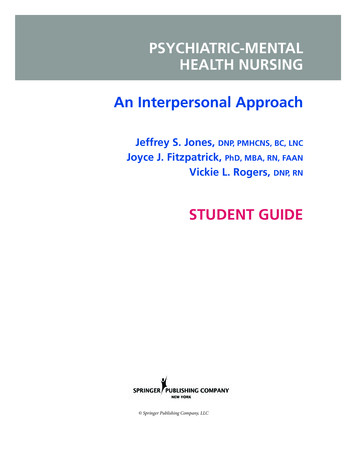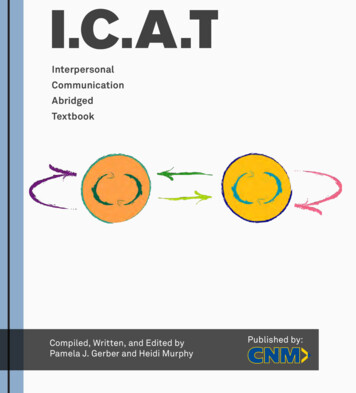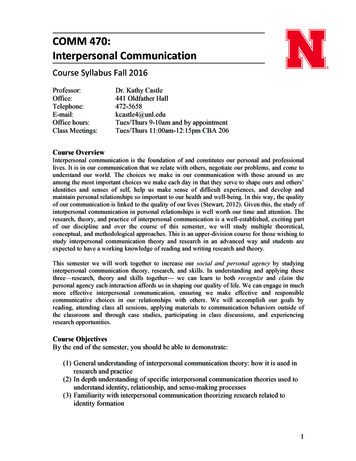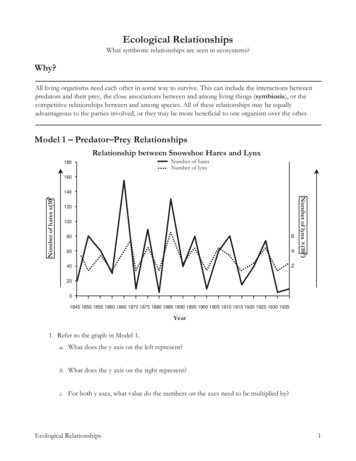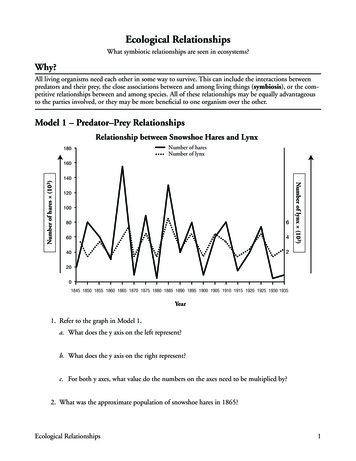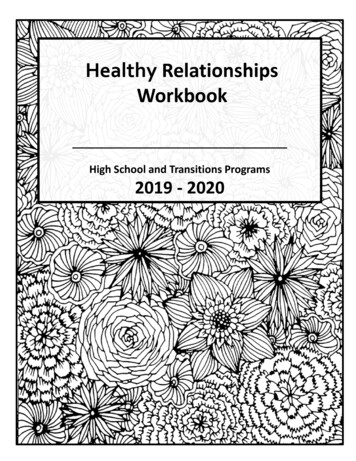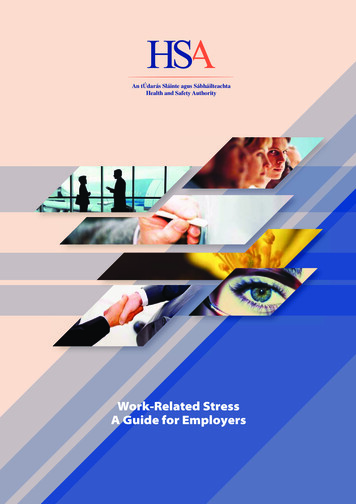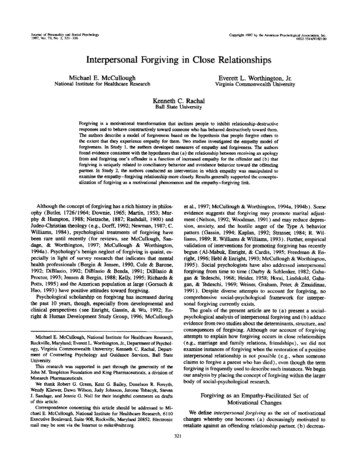
Transcription
Journal of Personality and Social Psychology1997, Vol. 73, No. 2, 321-336Copyright 1997 by the American Psychological Association, Inc.0022-3514/97/ 3,00Interpersonal Forgiving in Close RelationshipsMichael E. McCulloughEverett L. Worthington, Jr.National Institute for Healthcare ResearchVirginia Commonwealth UniversityKenneth C. RachalBall State UniversityForgiving is a motivational transformation that inclines people to inhibit relationship-destructiveresponses and to behave constructively toward someone who has behaved destructively toward them.The authors describe a model of forgiveness based on the hypothesis that people forgive others tothe extent that they experience empathy for them. Two studies investigated the empathy model offorgiveness. In Study 1, the authors developed measures of empathy and forgiveness. The authorsfound evidence consistent with the hypotheses that (a) the relationship between receiving an apologyfrom and forgiving one's offender is a function of increased empathy for the offender and (b) thatforgiving is uniquely related to conciliatory behavior and avoidance behavior toward the offendingpartner. In Study 2, the authors conducted an intervention in which empathy was manipulated toexamine the empathy-forgiving relationship more closely. Results generally supported the conceptualization of forgiving-as a motivational phenomenon and the empathy-forgiving link.Although the concept of forgiving has a rich history in philosophy (Butler, 1726/1964; Downie, 1965; Martin, 1953; Murphy & Hampton, 1988; Nietzsche, 1887; Rashdall, 1900) andJudeo-Christian theology (e.g., Dorff, 1992; Newman, 1987; C.Williams, 1984), psychological treatments of forgiving havebeen rare until recently (for reviews, see McCullough, Sandage, & Worthington, 1997; McCullough & Worthington,1994a). Psychology's benign neglect of forgiving is quaint, especially in light of survey research that indicates that mentalhealth professionals (Bergin & Jensen, 1990, Cole & Barone,1992; DiBlasio, 1992; DiBlasio & Benda, 1991; DiBlasio &Proctor, 1993; Jensen & Bergin, 1988; Kelly, 1995; Richards &Potts, 1995) and the American population at large (Gorsuch &Hao, 1993) have positive attitudes toward forgiving.Psychological scholarship on forgiving has increased duringthe past 10 years, though, especially from developmental andclinical perspectives (see Enright, Gassin, & Wu, 1992; Enright & Human Development Study Group, 1996; McCulloughet al., 1997; McCullough & Worthington, 1994a, 1994b). Someevidence suggests that forgiving may promote marital adjustment (Nelson, 1992; Woodman, 1991 ) and may reduce depression, anxiety, and the hostile anger of the Type A behaviorpattern (Gassin, 1994; Kaplan, 1992; Strasser, 1984; R. Williams, 1989; R. Williams & Williams, 1993). Further, empiricalvalidation of interventions for promoting forgiving has recentlybegun (AI-Mabuk, Enright, & Cardis, 1995; Freedman & Enright, 1996; Hebl & Enright, 1993; McCullough & Worthington,1995). Social psychologists have also addressed interpersonalforgiving from time to time (Darby & Schlenker, 1982; Gahagan & Tedeschi, 1968; Heider, 1958; Horai, Lindskold, Gahagan, & Tedeschi, 1969; Weiner, Graham, Peter, & Zmuidinas,1991). Despite diverse attempts to account for forgiving, nocomprehensive social-psychological framework for interpersonal forgiving currently exists.The goals of the present article are to (a) present a socialpsychological analysis of interpersonal forgiving and (b) adduceevidence from two studies about the determinants, structure, andconsequences of forgiving. Although our account of forgivingattempts to explain how forgiving occurs in close relationships(e.g., marriage and family relations, friendships), we did notexamine instances of forgiving when the restoration of a positiveinterpersonal relationship is not possible (e.g., when someoneclaims to forgive a parent who has died), even though the termforgiving is frequently used to describe such instances. We beginour analysis by placing the concept of forgiving within the largerbody of social-psychological research.Michael E. McCuUough, National Institute for Healthcare Research,Rockville, Maryland; Everett L. Worthington, Jr., Department of Psychology, Virginia Commonwealth University; Kenneth C. Rachal, Department of Counseling Psychology and Guidance Services, Ball StateUniversity.This research was supported in part through the generosity of theJohn M. Templeton Foundation and King Pharmaceuticals, a division ofMonarch Pharmaceuticals.We thank Robert G. Green, Kent G. Bailey, Donelson R. Forsyth,Wendy Kliewer, Dawn Wilson, Judy Johnson, Jerome Tobacyk, StevenJ. Sandage, and Jennie G. Noll for their insightful comments on draftsof this article.Correspondence concerning this article should be addressed to Michael E. McCullough, National Institute for Healthcare Research, 61 l0Executive Boulevard, Suite 908, Rockville, Maryland 20852. Electronicmail may be sent via the Interact to mike@nihr.org.Forgiving as an Empathy-Facilitated Set o fMotivational ChangesWe define interpersonal forgiving as the set of motivationalchanges whereby one becomes (a) decreasingly motivated toretaliate against an offending relationship partner, (b) decreas321
322McCULLOUGH, WORTHINGTON, AND RACHALingly motivated to maintain estrangement from the offender, and(c) increasingly motivated by conciliation and goodwill for theoffender, despite the offender's hurtful actions. Forgiving is notmotivation per se; rather, forgiving is the lay concept that peopleinvoke to describe the transformation that occurs when theirmotivations to seek revenge and to maintain estrangement froman offending relationship partner diminish, and their motivationto pursue conciliatory courses of action increases.Our definition of forgiving as a set of changes in one' s interpersonal motivations is similar to Rusbult, Verette, Whitney,Slovik, and Lipkus's (1991 ) conceptualization of accommodation in close relationships. Rusbult et al. defined accommodationas the willingness to inhibit impulses to act destructively andthe willingness to act constructively in response to the hurtfulactions of a close relationship partner. Their concept of accommodation appears to be quite similar to our understanding ofthe concept of forgiving. Rusbult et al. adduced evidence fromseveral studies to demonstrate that accommodation is related toa variety of relationship factors, including partners' relationshipsatisfaction, overall relational functioning, and commitment tothe relationship. Although relational commitment and overallrelational functioning appear to be important determinants ofaccommodation (and thus, perhaps, forgiving), it might also beproductive to enquire into the nature of the more proximal social-psychological factors that lead to this set of prosocialchanges in one's motivations toward an offending relationshippartner.We hypothesized that empathy for the offending partner isthe central facilitative condition that leads to forgiving. A varietyof prosocial phenomena, such as cooperation, altruism, and theinhibition of aggression appear to be facilitated by empathy forthe other person (Batson, 1990, 1991; Batson & Oleson, 1991;Eisenberg & Fabes, 1990; Eisenberg & Miller, 1987; Hoffman,1981, 1990; Moore, 1990; Rusbult et al., 1991; Tangney, 1991 ).We believe that forgiving is similar to these other prosocialphenomena in that it is also facilitated by empathy. Empathycan be defined as a vicarious emotion that is congruent withbut not necessarily identical to the emotion of another person(Batson & Shaw, 1991 ). Empathy incorporates concepts such assympathy, compassion, and tenderness (Batson, 1991; Batson &Shaw, 1991 ). Although empathy is primarily an affective phenomenon, the ability to take the cognitive perspective of anotherperson (i.e., perspective taking) appears to be an importantcognitive analogue to empathic affect that may be relevant forunderstanding how empathic affect develops (Batson & Shaw,1991; Coke, Batson, & McDavis, 1978). Thus we also considerperspective taking as an important, if secondary, element ofempathy.A n Analysis o f Forgiving B a s e d on B a t s o n ' s E m p a t h y A l t r u i s m HypothesisIt is useful to think of the relationship among empathy, forgiving, and resulting behavioral responses toward an offendingrelationship partner as genotypically similar to the sequence ofevents by which empathy leads to the motivation to care forothers (i.e., altruism) when no such motivation existed prior tothe experience of empathy and how that altruistic motivationcan produce behavioral outcomes (e.g., helping, allocating re-sources in a social dilemma, cooperating). When people acquirea measure of empathy for another person's welfare, they aremore likely to help that person when he or she is in need (Batson & Oleson, 1991 ). Although empathy may create many potential motives for helping another person (some of which arethoroughly egoistic), in some cases, as Batson and his colleagues (e.g., Batson, 1990, 1991; Batson et al., 1995; Batson &Oleson, 1991 ) have posited, empathy motivates people to helpothers, including total strangers, by activating the human capacity for altruism. A similar analysis can be used to clarify ourmodel of the process by which forgiving occurs. However, theinterpersonal context in which forgiving occurs is more complexthan the typical situation in which one acquires altruistic motivation to help a stranger.The interpersonal relationship in which the forgiving becomesrelevant, whether a family relationship, a romantic relationship,or a friendship, is usually characterized by a shared historyand is often strengthened by a considerable base of positiveattachment. Against this backdrop of shared history and (perhaps) positive attachment, both relationship partners typicallyexperience a sense of well-being in the relationship and aregenerally motivated to behave positively toward each other.However, the occurrence of a destructive, harmful, or offensiveaction by one relationship partner can upset this state of relational well-being (Gottman, 1994).Because of the perceptual salience of a painful interpersonaloffense, the offended partner's immediate disposition canchange from a feeling of well-being, comfort, and the inclinationto behave constructively toward the relationship partner to aninclination to retaliate against the offending partner, to avoidinterpersonal or psychological contact with the offending partner, or both. These negative motivational changes might be indirect proportion to the perceived hurtfulness of the offense(Rusbult et al., 1991 ). If the offense is sufficiently salient, thesemotivational changes are likely to occur even in relationshipsthat were close and well-adjusted prior to the offense.The primacy of the tendencies toward revenge and avoidancein response to interpersonal offenses can be illustrated by usingthe results of Gottman's (1994) research on close relationships.Gottman found that people's affective responses to theirspouses' hurtful actions take two forms: righteous indignation(e.g., sadness, anger, and contempt) and hurt and perceivedattack (e.g., intemal whining, innocent victirnhood, fear, andworry). We posit that these two affective reactions--righteousindignation and hurt-perceived attack--motivate revenge or estrangement behaviors that are intended to protect the self or tokeep the offender at a safe interpersonal or psychological distance from the offending relationship partner (Rusbult et al.,1991). These revenge and estrangement behaviors potentiallylead to the further deterioration of the relationship.Obviously, the typical close relationship in which forgivingoccurs is quite different than the typical interpersonal situationthat has been used to conceptualize altruism. Nevertheless, theempathy-altruism analysis can shed light on the more complexinterpersonal situation that occasions forgiving. In this emotional climate of the damaged close relationship, where the offended relationship partner is motivated to enact relationshipdestructive responses to the offending partner's hurtful actions,the offended partner might, through any of a variety of personal-
INTERPERSONAL FORGIVINGity or situational factors, acquire empathy for the offendingrelationship partner.At this point in our analysis, we invoke Batson's (1990,1991 ) analysis of the empathy-altruism link to conceptualizehow forgiving occurs. In the same way that empathy can facilitate caring for a person in need who was previously unknownto the actor, the emergence of empathy for an offending relationship partner can elicit the offended partner's capacity to carefor the needs of the offending partner. In the context of a closerelationship that has been damaged by the hurtful actions ofone relationship partner, this empathy-elicited caring may bedirected at three foci. First, empathy may cause the offendedpartner to care that the offending partner is experiencing guiltand distress over how his or her actions hurt the offended partnerand damaged their relationship (Baumeister, Stillwell, & Heatherton, 1994). Second, empathy may cause the offended partnerto care that the offending partner feels isolated or lonely becauseof their estranged relationship. Third, and perhaps most directly,empathy for the offending relationship partner may simply leadthe offended relationship partner to care for restoring thebreached relationship with the offending partner. In other words,empathy may lead to a yearning for restored positive contactwith the offender.Increases in these three forms of empathy-elicited caring forthe offender reduce the relative salience of the offending partner's hurtful actions, thereby reducing the power of the offender's hurtful actions to elicit motivations toward revenge and themaintenance of estrangement. In place of these motivations forrevenge and the maintenance of estrangement, the increase incaring for the offending partner increases the offended partner'smotivation to pursue conciliatory courses of action toward theoffending relationship partner that will relieve the partner's distress and perhaps contribute to the restoration of the relationship(McCullough et al., 1997).Personality, situational, and relationship factors might influence the timing with which empathy develops and perhapswhether empathy for the offending partner develops at all. Forexample, the offended partner's dispositional empathy (e.g.,Davis, 1980) appears be weakly related to the degree to whichpeople forgive relationship partners who have hurt them (Rhode,1990). However, global personality factors such as dispositionalempathy might be weak determinants of forgiving (cf. Rt sbultet al., 1991 ), because they must be translated into empathy fora specific person in a specific situation. Thus situational andrelationship factors could be more important determinants ofwhether and how empathy develops. The severity of the offenseand the degree to which the offender apologizes for his or herbehavior, for example, might be crucial (Weiner, Graham, Peter, & Zmuidinas, 1991; Rusbult et al., 1991 ). In addition, relationship factors, such as those identified by Rusbult et al. asimportant determinants of accommodation, might influence thecapacity to develop empathy for the offending relationship partner. Regardless of the pathways by which empathy for the offending partner develops, we posit that once it has exceeded acertain level, the perceptual salience of the empathy for theoffender overshadows the perceptual salience of the offendingpartner's hurtful actions, leading to the set of motivationalchanges that we have defined as forgiving.323S u m m a r y and HypothesesOn the basis of this conceptual analysis, we posit that forgiving and altruism have similar deep structures, despite their surface dissimilarities. We conceptualize forgiving as a motivational transformation that inhibits an injured relationship partnerfrom seeking revenge or maintaining estrangement from an offending relationship partner and inclines them to behave in conciliatory ways instead. Empathy is conceptualized as a crucialfacilitative condition for overcoming the primary tendency toward destructive responding following a significant interpersonal offense. On the basis of this conceptual analysis, we propose three hypotheses:Hypothesis 1: Empathy mediates relationships between dispositional or environmental variables and their causal effects onforgiving. We expected to find high positive correlations between a wronged person's empathy for an offender and reportedforgiving for the offender. We also expected to find variablesthat increase the likelihood of forgiving to be mediated by empathy. For example, we expected that the apology-forgiving relationship identified by Darby and Schlenker (1982) and Weineret al. ( 1991 ) would be mediated by the effects of apologies onthe offended partner' s empathy for the offender.Hypothesis 2: Forgiving promotes constructive actions towardthe offender and inhibits destructive actions toward the offenderfollowing an interpersonal offense. We hypothesized that whenpeople forgive, they become more inclined to respond constructively, and their inclinations to respond destructively are reduced.Moreover, because forgiving !s mediated by empathy, forgivingis causally more proximal (and thus more strongly related) tothese behavioral outcomes than is empathy.Hypothesis 3: Clinical efforts to influence clients' capacityto forgive will succeed insofar as they induce empathy for theoffender. We expected that clinical interventions that producechange on measures of forgiving would also encourage changeon measures of empathy (regardless of whether the interventiontargeted empathy). Further, interventions that seek to promoteforgiving by increasing people's empathy for their offenderswere expected to be successful to the extent that they actuallypromote increased empathy. The relationship of empathy andforgiving in such intervention studies should be consistent withthe hypothesis that change in forgiving over time is mediatedby changes in empathy for the offender over time.To test these hypotheses, we conducted two studies. Our goalswere to (a) develop measures of forgiving and empathy thatwere empirically and conceptually distinct; (b) assess whetherempathy exerts a mediational influence on self-reported forgiving; and (c) examine whether the relations among empathy,forgiving, conciliatory behavior, and avoidance behavior wereconsistent with a motivational conceptualization of forgiving.Study 1It is well established that receiving an apology from one'soffender encourages forgiving (Darby & Schlenker, 1982; Davidson & Jurkovic, 1993; Enright, Santos, & AI-Mabuk, 1989;Huang, 1990; Weiner et al., 1991 ), particularly when apologiesare elaborate and include admissions of guilt (Darby &Schlenker, 1982; Weiner et al., 1991 ). Weiner et al. suggested
324McCULLOUGH, WORTHINGTON, AND RACHALthat apologies facilitate forgiving by interrupting the offendedpartner's inference that an offender's acts correspond to andderive from the offender's character (i.e., they interrupt the operation of the fundamental attribution error). However, on thebasis of the empathy model of forgiving, we hypothesized thatthe relationship between apology and forgiving can also be explained as a function of increased empathy for the offender.The expression of an apology may lead to the perception thatthe offending partner is experiencing guilt and emotional distressdue to his or her awareness of how the hurtful actions harmedthe offended partner (Baumeister et al., 1994). The offendedpartner's recognition o f the offender's guilt and emotional distress over his or her hurtful actions promotes empathy for theoffender. To the extent that the offended partner experiencesempathy for the offending partner, the offended partner is expected to experience reduced motivations toward revenge andthe maintenance of estrangement and, instead, to experienceincreased motivations to pursue a conciliatory course of action(i.e., to forgive), much as empathy leads to an increased motivation to care for others and thus to prosocial b e h a v i o r in othersocial situations (cf. Batson, 1990, 1991).In Study 1, we examined whether the well-established linkbetween apology and forgiving was mediated by empathy forthe offending partner and whether forgiving leads to increasedconciliatory b e h a v i o r and decreased avoidance behavior following the offense. As a prelude to examining the a p o l o g y - f o r g i v ing link, we developed empirically and conceptually distinctmeasures of empathy and forgiving.MethodParticipantsParticipants (N 239) were 131 female and 108 male universityundergraduates (mean age 19) representing several ethnic groups(83% White, 14% Black, 3% other). Participants received a smallamount of extra course credit for their participation.MeasuresDemographic and ofense-related information. Participants indicated their age, gender, relationship with the person who had hurt them,the amount of time since the offense occurred, and a brief descriptionof the offense. Most of the offenders whom participants described wereromantic partners (48%), relatives ( 18% ), or friends of the same gender(18%).By using a 5-point Likert-type item, participants indicated the degreeto which the offense had hurt them (M 4.0 [i.e., much hurt], SD 1. l ). By using a 6-point Likert-type item that ranged from 0 (stronglydisagree) to 5 (strongly agree), participants indicated their degree ofagreement with the statement, "The person was not wrong in what he/she did to me" (M 0.87, SD 1.2). Thus participants experiencedthe typical offense as both hurtful and wrong.Perceived degree of apology. The extent to which participants perceived that the offender apologized for the offense was measured witha scale consisting of two 5-point Likert-type items that ranged from 1(strongly disagree) to 5 (strongly agree). Items elicited the degree towhich participants perceived that their offenders apologized and attempted to explain their hurtful behavior. Cronbach's alpha for this scalewas .79.Affective empathy. Batson's eight-item empathy scale (Archer, DiazLoving, Gollwitzer, Davis, & Foushee, 1981; Batson, Bolen, Cross, &Neuringer-Benefiel, 1986; Batson, O'Quin, Fultz, Vanderplas, & Isen,1983; Coke et al., 1978; Fultz, Batson, Fortenbach, McCarthy, & Varney,1986; Toi & Batson, 1982) consists of eight affects that participantsrated on a 6-point scale that ranged from 0 (not at all) to 5 (extremely) toindicate the degree to which they felt each affect (sympathetic, empathic,concerned, moved, compassionate, warm, softhearted, and tender) fortheir offender at the time of the rating.Factor analytic investigations (Batson et al., 1983; Coke et al., 1978;Toi & Batson, 1982) have found these adjectives to load on a singlefactor that is orthogonal to a factor measuring personal distress. Internalconsistency estimates have ranged from .79 to .95. The scale was foundto be moderately correlated with measures of dispositional empathy,perspective taking, and helping behavior (Batson et al., 1986; Eisenberg & Miller, 1987). Some subset of these items has been used innearly every study of the empathy-altrnism hypothesis in the past 20years to adduce evidence that empathy manipulations did in fact manipulate empathy (e.g., Batson, Turk, Shaw, & Klein, 1995; Coke et al.,1978; Toi & Batson, 1982). Thus the construct validity of this empathymeasure is generally assumed to be very good.Forgiving. A fve-item measure of forgiving assessed the degree towhich the respondent experienced a constructive disposition and theabsence of a destructive disposition in light of the offending partner'shurtful actions. These five items were as follows: "I wish him/her well","I disapprove of him/her", "I think favorably of him/her", "I condemnthe person", and "I have forgiven the person". The first four items wereendorsed on a 6-point scale that ranged from 0 (strongly disagree) to5 (strongly agree). The forgiving item was endorsed on a 5-point scalethat ranged from 1 (I have not at all forgiven) to 5 (1 have completelyforgiven ). Internal consistency ( Cronbach' s alpha ) was estimated at.87.The sample mean on this scale was 16.8 (SD 6.7) based on a rangefrom 1 to 25.Forgiveness-related items. Twenty items from Wade's (1989) Forgiveness Scale were used to examine the discriminant validity of theempathy measure and forgiving measure. In an initial effort to developoperational definitions of forgiving, Wade conducted interviews with 20academic psychologists, clinical psychologists, and pastors about thenature of forgiving. On the basis of these interviews, Wade generated600 items that captured elements of how the experts defined forgiving.Wade (1989) reduced this set of 600 items to a smaller set, which sheadministered to 282 college students who were instructed to completethe items as they thought about a relationship partner who had offendedthem in the past. Half the students were instructed to think of an offending partner whom they had forgiven, and half were instructed tothink of an offending partner whom they had not forgiven. Eighty-threeitems significantly distinguished between the students who completedthe items under the forgiveness set and the students who completed theitems under the nonforgiveness set. Thus, the resulting items were bothreflective of psychologists' and pastors' understandings of forgiving andempirically distinguished between forgiving and nonforgiving. We reasoned that if our five-item forgiving measure indeed measured forgiving,then it should be related to Wade's items even after partialing out variance that can be attributed to the empathy measure, whereas the empathymeasure should have very small relationships with these 20 items afterpartialing out variance that can be attributed to the five-item forgivingmeasure.Conciliatory behaviors toward the offender. This measure consistedof two items that measured the degree to which respondents had engagedin two behaviors that indicated attempts at reconciliation with the offender ( " I tried to make amends" and "I took steps toward reconciliation: Wrote them, called them, expressed love, showed concern, etc.").Internal consistency (Cronbach's alpha) was estimated as .74. The sample mean on this scale was 6.7 (SD 2.5) based on a range from 2 to10. For this scale and the avoidance behaviors subscale described below,
INTERPERSONAL FORGIVING325Table 1Means, Standard Deviations, Internal Consistency Reliabilities,and lntercorrelations (Study 1)Variable1.2.3.4.5.Degree of apologyEmpathyForgivingConciliatory behaviorAvoidance **.63**-.58**-.70**-.73**-.56**5Note. Apology scores ranged from 2 to 10. Empathy scores ranged from 0 to 20. Forgiving Scale scoresranged from 5 to 25. Conciliatory behavior scores ranged from 2 to 10. Avoidance behavior scores rangedfrom 3 to 15.** p .01.items were endorsed on a 5-point Likert-type format that ranged from1 (strongly disagree) to 5 (strongly agree).Avoidance behaviors toward the offender. This measure consistedof three items that measured the degree to which respondents engagedin behaviors to avoid contact with the offender ( "I keep as much distancebetween us as possible", " I avoid them", and " I withdraw fromthem" ). Internal consistency (Cronbach's alpha) was estimated as .90.The sample mean on this scale was 10.1 (SD 3.9) based on a rangefrom 3 to 15.ProcedureParticipants completed packets that contained consent forms and thequestionnaire measures described above. After providing demographicinformation, participants read the following instructions:We ask you now to think of one person whom you experienced astreating you unfairly and hurting you at some point in the past. Fora moment, visualize in your mind the events and the interactions youmay have had with the person who offended you. Try to visualize theperson and recall what happened. Below is a set of questions aboutthe person who hurt you. It is possible that you have experiencedthis type of hurt from more than one person, but please answer thequestions that follow as you focus on a single person who hurt you.After reading the instructions, participants described the interpersonalinjury they had received and then completed the empathy, forgiving, andbehavioral self-report measures.ResultsDescriptive StatisticsMeans, standard deviations, internal consistency reliabilities,and correlations of all variables in Study 1 appear in Table 1.Refinement o f the Forgiving and Empathy MeasuresMeasurement model. Although a preliminary principalcomponents factor analysis of the eight items from B a t s o n ' sempathy measure and the five items from the forgiving measureindicated that two factors with eigenvalues greater than 1.0 werepresent, three items on the empathy measure loaded on bothfactors. After removing these three items, a fourth item wasremoved from the empathy measure to boost internal consistency. The resulting empathy measure consisted of four adjectives (empathic, concerned, moved, and softhearted) and h a dan internal consistency o f .88. All five items on the forgivingmeasure appeared to load only on one factor, thus all five itemswere retained. The five-item forgiving measure had an internalconsistency of .87.We tested two competing models o f the structural relationsamong the four items retained for the empathy measure and thefive items on the forgiving measure by using the EQS (Version5) statistical program ( B e n d e r & Wu, 1995). The correlatedfactors model posited that the five forgiving items and the fourempathy items were indicators for two distinct but correlatedfactors (i.e., Forgiving and E m p a t h y ) . The single-factor modelposited th
ment of Counseling Psychology and Guidance Services, Ball State University. This research was supported in part through the generosity of the John M. Templeton Foundation and King Pharmaceuticals, a division of Monarch Pharmaceuticals. We thank Robert G. Green, Kent G. Bailey, Donelson R. Forsyth,
